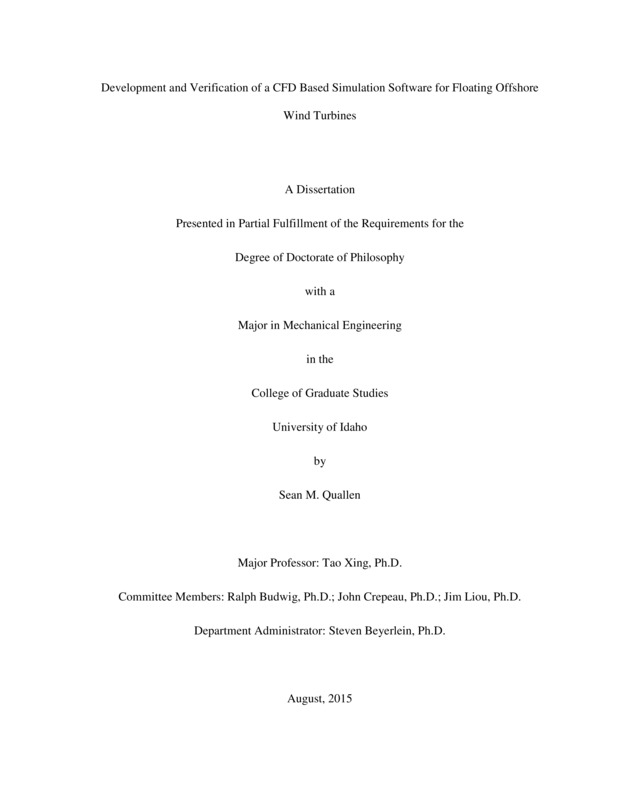Development and Verification of a CFD Based Simulation Software for Floating Offshore Wind Turbines
Quallen, Sean Michael. (2015). Development and Verification of a CFD Based Simulation Software for Floating Offshore Wind Turbines. Theses and Dissertations Collection, University of Idaho Library Digital Collections. https://www.lib.uidaho.edu/digital/etd/items/quallen_idaho_0089e_10672.html
- Title:
- Development and Verification of a CFD Based Simulation Software for Floating Offshore Wind Turbines
- Author:
- Quallen, Sean Michael
- Date:
- 2015
- Keywords:
- Collective blade-pitch control Computational fluid dynamics Floating wind turbines Mooring lines Variable-speed control Wind turbulence
- Program:
- Mechanical Engineering
- Subject Category:
- Engineering; Alternative energy
- Abstract:
-
A coupled aerodynamic-hydrodynamic-servo simulation software capable of motion and performance predictions for floating offshore wind turbines (FOWT) is developed. The computational fluid dynamics (CFD) solver CFDShip-Iowa is used for pressure, velocity, and motion predictions. A multi-segmented mooring line model (crowfoot) is designed for securing the turbine and limiting motions. Variable-speed (VS) and blade-pitch (BP) controllers designed by the National Renewable Energy Laboratory (NREL) are also utilized to help maximize power and to prevent generator overload.
The developed software is demonstrated with multiple simulation load cases (LC) from the Offshore Code Comparison Collaboration (OC3), increasing complexity with each simulation. Free-decay tests are first performed for hydrodynamic validation against experimental data provided by the OC3 using a coarse grid set. A URANS simulation featuring steady wind and regular wave patterns, modeled after the OC3's LC 5.1, is performed with a fixed rotor rotational velocity. The motion and aerodynamic power predictions are compared to those of NREL's OC3 results.
A finer gridset is constructed and utilized in a study of offshore blade-tower interaction (BTI) to determine the effect of unsteady platform motions on the aerodynamic disruption caused by the blade passing directly upwind of the tower. The results show that BTI effects are strongly affected by platform motions, notably in pitch, and that BTI is more significantly affected by platform velocities than by overall displacements.
This finer gridset is again utilized, but combined with a VS controller in a duplicate LC 5.1 simulation using DDES. The drivetrain is modeled with rotational inertia allowing for prediction of the rotor velocity based on developed generator torque. Generator torque and power predictions are compared to NREL's results. The present results agree in frequency trends but predict separation on blades during platform upstream pitching and surging.
The BP controller is employed in a simulation modeled after the OC3's LC 5.2, which uses irregular waves and the Mann wind turbulence model. Results are transformed to the frequency domain for comparison with NREL. The present results agree with NREL generated torque and power. Grid dissipation and modeling error in the present study produce less overall wind and wave fluctuations.
- Description:
- doctoral, Ph.D., Mechanical Engineering -- University of Idaho - College of Graduate Studies, 2015
- Major Professor:
- Xing, Tao
- Committee:
- Budwig, Ralph; Crepeau, John; Liou, Jim
- Defense Date:
- 2015
- Identifier:
- Quallen_idaho_0089E_10672
- Type:
- Text
- Format Original:
- Format:
- application/pdf
- Rights:
- In Copyright - Educational Use Permitted. For more information, please contact University of Idaho Library Special Collections and Archives Department at libspec@uidaho.edu.
- Standardized Rights:
- http://rightsstatements.org/vocab/InC-EDU/1.0/

